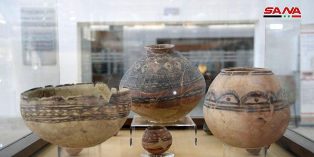The National Museum of Aleppo has reopened its doors to visitors and archaeologists after eight years of closure due to the terrorist war on Syria.
“Re-opening the museum to display 50 thousand pieces of its archaeological treasures is considered as an announcement of the return of life to this unique museum as well as a message of peace, love and knowledge to confirm that the Syrian people have triumphed over terrorism, aggression and injustice” Director General of Antiquities and museums Dr. Mahmoud Hamoud said in a press statement.
He made it clear that the rehabilitation work of the museum was done in cooperation with Japan and the United Nations Developmental Program UNDP.
A number of foreign archaeologists, who attended the opening, underscored that re-opening the museum is part of the reconstruction process Syria is witnessing and it brings together archeologists, intellectuals and scholars.
The National Museum of Aleppo has an important human and cultural memory and an archaeological and heritage value. It is a unique witness of the development of the Syrian culture and civilization throughout the ages of Aramaic, Assyrian, Chaldean and Phoenician.
 The museum, which is considered as one of the most important archeological facilities in the world, was classified as a regional museum because of its archeological contents, some of them date back to BC ages and some others are immortal artworks by great artists from Aleppo province.
The museum, which is considered as one of the most important archeological facilities in the world, was classified as a regional museum because of its archeological contents, some of them date back to BC ages and some others are immortal artworks by great artists from Aleppo province.
No historian or archaeologist can reach an advanced level of science unless he visits this museum because it is considered as one of the most important educational institutions in the field of archeology.
The Aleppo Museum was built in 1931 at a palace which was built in 1924. When the building became unable to receive more archeological pieces , the Directorate of Antiquities decided to build a new building with modern museum conditions. Later, A new modern museum opened in 1972.
The museum includes five sections representing certain historical periods : “Prehistoric Antiquities”, “Syrian Antiquities from Oriental eras” , “Classical Syrian Antiquities”,” Arab-Islamic Antiquities” and “Modern Art”.
The sections display magnificent exhibits to stress the capabilities of the Syrian people who have mastered the arts of sculpture, engraving and decoration.
The museum embraces two internal courtyards and some huge basalt statues of some ancient gods, Hittite Hieroglyphic writings from the first millennium BC in addition to the Roman statues and mosaics from the third century AD. One of the masterpieces preserved in the museum is the statue of an elite French writer from Mary Kingdom in III millennium BC and the statue of a bronze gilded god dating back to the II millennium BC .
The Aleppo National Museum was exposed to material damage during the terrorist war as it has been targeted with tens of rocket and mortars by Takfiri terrorists.
Rawaa Ghanam


 Home
Home